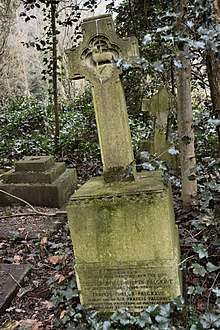Francis Turner Palgrave
Francis Turner Palgrave (/ˈpɔːlɡreɪv, ˈpæl-/;[1] 28 September 1824 – 24 October 1897) was a British critic, anthologist and poet.

Life
He was born at Great Yarmouth, the eldest son of Sir Francis Palgrave, the historian and his wife Elizabeth Turner, daughter of the banker Dawson Turner. His brothers were William Gifford Palgrave, Robert Harry Inglis Palgrave and Reginald Palgrave. His childhood was spent at Yarmouth and at his father's house in Hampstead. At fourteen he was sent as a day-boy to Charterhouse; and in 1843, having in the meanwhile travelled extensively in Italy and other parts of the continent, he won a scholarship at Balliol College, Oxford. In 1846 he interrupted his university career to serve as assistant private secretary to Gladstone, but returned, to Oxford the next year, and took a first class in Literae Humaniores. From 1847 to 1862 he was fellow of Exeter College, and in 1849 entered the Education Department at Whitehall.

In 1850 Palgrave accepted the vice-principalship of Kneller Hall Training College at Twickenham. There he came into contact with Alfred Tennyson, and laid the foundation of a lifelong friendship. When the training college was abandoned, Palgrave returned to Whitehall in 1855, becoming examiner in the Education Department, and eventually assistant secretary. He married, in 1862, Cecil Grenville Milnes, daughter of James Milnes-Gaskell.[2] In 1884 he resigned his position at the Education Department, and in the following year succeeded John Campbell Shairp as professor of poetry at Oxford. There was a minor scandal in 1862 when Palgrave was commissioned to write a catalogue for the 1862 International Exhibition, in which he praised his friend the sculptor Thomas Woolner and denigrated other sculptors, especially Woolner's main rival Carlo Marochetti. The well known controversialist Jacob Omnium pointed out in a series of letters to the press that the two lived together. William Holman Hunt wrote a reply supporting Palgrave and Woolner,[3] but Palgrave was forced to withdraw the catalogue. He died in London, and was buried in the cemetery on Barnes Common.
Poet/critic
Palgrave published both criticism and poetry, but his work as a critic was by far the more important. His Visions of England (1880–1881) has dignity and lucidity, but little of the "natural magic" which the greatest of his predecessors in the Oxford chair considered to be the test of inspiration. His last volume of poetry, Amenophis, appeared in 1892. His criticism is considered to demonstrate fine and sensitive tact, quick intuitive perception, and generally sound judgment. His Handbook to the Fine Arts Collection, International Exhibition, 1862, and his Essays on Art (1866), though flawed, were full of striking judgments strikingly expressed.
His Landscape in Poetry (1897) showed wide knowledge and critical appreciation of one of the most attractive aspects of poetic interpretation. But Palgrave's principal contribution to the development of literary taste was contained in his Golden Treasury of English Songs and Lyrics (1861), an anthology of the best poetry in the language constructed upon a plan sound and spacious, and followed out with a delicacy of feeling which could scarcely be surpassed. Palgrave followed it with a Treasury of Sacred Song (1889), and a second series of the Golden Treasury (1897), including the work of later poets, but in neither of these was quite the same exquisiteness of judgment preserved. Among his other works were The Passionate Pilgrim (1858), a volume of selections from Robert Herrick entitled Chrysomela (1877), a memoir of Arthur Hugh Clough (1862) and a critical essay on Sir Walter Scott (1866) prefixed to an edition of his poems. He published a small collection of hymns in 1867 which ran to three editions, each slightly enlarged.[4]
See Gwenllian F Palgrave, F. T. Palgrave (1899).
Notes
- "Palgrave". Collins English Dictionary.
- Gamble, Cynthia, 2015 Wenlock Abbey 1857–1919: A Shropshire Country House and the Milnes Gaskell Family, Ellingham Press.
- James H. Coombs, A Pre-Raphaelite friendship: the correspondence of William Holman Hunt and John Lucas Tupper, UMI Research Press, 1986, p.133.
- Palgrave, Francis Turner (1867). Hymns. London: Macmillan. pp. 34.
References


- Wroth, Warwick William (1895). . In Lee, Sidney (ed.). Dictionary of National Biography. 43. London: Smith, Elder & Co.
- Otton, Megan Nelson. "Palgrave, Francis Turner (1824–1897)". Oxford Dictionary of National Biography (online ed.). Oxford University Press. doi:10.1093/ref:odnb/21158. (Subscription or UK public library membership required.)
External links
| Wikiquote has quotations related to: Francis Turner Palgrave |
| Wikimedia Commons has media related to Francis Turner Palgrave. |